 Identifying as a Jew
Identifying as a Jew


16 min read
Despite the overwhelming evidence, why do some archeologists claim that Hebron was uninhabited during the times of Moses and Joshua?
The city of Hebron presents a problem to the Biblical archaeologist. Ancient Hebron, located a few miles west of the Dead Sea and about 20 miles south of Jerusalem, figures prominently in the Jewish Bible, mentioned more than 70 times. Hebron is known to be one of the oldest cities in the world. Josephus Flavius, the noted first century CE Jewish historian, stated that in his time Hebron was already 2,300 years old!1
 The city with its rolling hills and vineyards is closely identified with the Patriarch Abraham. When Abraham's wife, Sarah, died, he purchased a burial site for her in Hebron.2 The tomb was located inside a cave that has been known through the ages as the Cave of the Patriarchs. Jewish tradition reveals that Adam and Eve are also buried there. Subsequent to Sarah, all the patriarchs and matriarchs -- Abraham, Isaac, Jacob, Rebecca, and Leah were all buried there. Only Rachel, the second wife of Jacob, was buried elsewhere, in Bethlehem. During the reign of King Herod (first century, BCE) the Cave of the Patriarchs was completely enclosed by a fortress-like structure, still standing today.
The city with its rolling hills and vineyards is closely identified with the Patriarch Abraham. When Abraham's wife, Sarah, died, he purchased a burial site for her in Hebron.2 The tomb was located inside a cave that has been known through the ages as the Cave of the Patriarchs. Jewish tradition reveals that Adam and Eve are also buried there. Subsequent to Sarah, all the patriarchs and matriarchs -- Abraham, Isaac, Jacob, Rebecca, and Leah were all buried there. Only Rachel, the second wife of Jacob, was buried elsewhere, in Bethlehem. During the reign of King Herod (first century, BCE) the Cave of the Patriarchs was completely enclosed by a fortress-like structure, still standing today.
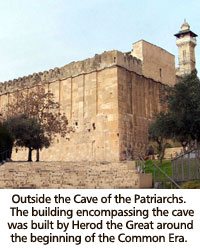 The Bible tells us that during the journey of the Israelites through the wilderness to the Promised Land, Moses sent 12 men to spy out the land of Canaan. The last city the spies investigated was the city of Hebron. Outside the city was a valley in which grapes grew in huge clusters. The spies cut down one of the large clusters and carried it back to the camp of the Israelites.3
The Bible tells us that during the journey of the Israelites through the wilderness to the Promised Land, Moses sent 12 men to spy out the land of Canaan. The last city the spies investigated was the city of Hebron. Outside the city was a valley in which grapes grew in huge clusters. The spies cut down one of the large clusters and carried it back to the camp of the Israelites.3
After the death of Moses, Joshua led the Children of Israel in a series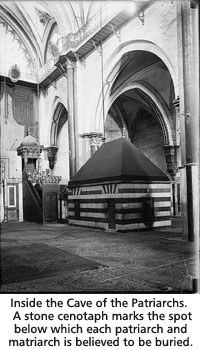 of battles for the conquest of Canaan. The king of Hebron played a prominent role in the failed battle against Joshua.4 Years later, Hebron served as the capital city for the newly anointed king, David. For seven and a half years, Hebron was the political center of Israel, until the conquest of Jerusalem.5 Jerusalem then became the new capital, but reverence for Hebron, with its spiritual and historical legacy, was maintained, and remains so to this very day.
of battles for the conquest of Canaan. The king of Hebron played a prominent role in the failed battle against Joshua.4 Years later, Hebron served as the capital city for the newly anointed king, David. For seven and a half years, Hebron was the political center of Israel, until the conquest of Jerusalem.5 Jerusalem then became the new capital, but reverence for Hebron, with its spiritual and historical legacy, was maintained, and remains so to this very day.
Hebron was first excavated by Philip Hammond of the Princeton Theological Seminary in 1963.6 Hammond's work was interrupted by the Six Day War in 1967. Because Hammond was called to Jordan to conduct a new expedition, he was only able to rewrite and publish a small part of his Hebron findings; the remainder of his notes were stashed in his desk drawer. The published works of Hammond told of Middle Bronze Era (Patriarchal Era, Abraham) finds in Hebron and a wealth of discoveries dating to the Iron Age, the era of King David. There was no mention of Late Bronze findings -- the time that Moses' spies were sent out to Hebron and the time of Joshua's conquest. Archaeologists hastily concluded that there is little doubt that Hebron was an inhabited city during the Patriarchal Era, in the time of Abraham. Likewise, there is little doubt that it was inhabited in the time of King David. However, there is a great deal of doubt if Hebron was inhabited during the time of Moses and his spies or if it was inhabited during the time of Joshua's conquest, calling into question part of the Biblical narrative.
Is the skepticism of the academics warranted or is it possibly motivated by some hidden agenda?
A number of noted historians and archaeologists jumped on the Bible-bashing bandwagon and boldly claimed that Hebron was uninhabited during the Late Bronze age (1550-1250 BCE), when the incident of the spies occurred and was likewise uninhabited during Early Iron age (1250-1000 BCE), during which time Joshua conquered Canaan.7 William Stiebing Jr., professor of history at the University of New Orleans, writes, "The absence of Late Bronze Age remains at Hebron indicates ...that the Biblical accounts of those events are not historically accurate."8 His skepticism was shared by many other Bible critics, historians, and archaeologists.9
Is the skepticism of the academics warranted or is it possibly motivated by some hidden agenda? As we investigate, we shall discover that the aforementioned academics have made a total of six serious blunders.
Blunder number one: Hebron is not a single archaeological site, but rather it is a sprawling archaeological area consisting of seven distinct sites. They are:
1) Tel Hebron, also called Tel Rumeide, where Hammond conducted his excavations.
2) Haram el-Khalil, which includes the Cave of the Patriarchs and its surrounding area. Due to the reverence given to the site, no archaeological excavations have ever been conducted in this area.
3) The present-day city of Hebron. Since it is inhabited, very little has been done in the way of archaeological work.
4) Jebel Nimra, a site of known Persian-era construction. Recent archaeological work has been started there, but no reports have been released as yet.
5) Haram Ramet el-Khalil. According to local tradition, this is the site of the patriarchal Hebron.10 No archaeological work has been conducted there as yet.
6) Khirbet en-Natzara, a site known to contain artifacts11 that date back to the conquest era, but the area has not been excavated.
7) Jebel Batrak, unexamined.
The fact is that only one of the archaeological sites in Hebron, namely Tel Hebron, was partially excavated by Hammond. That no evidence of habitation was found coinciding with the epic of Moses' spies and Joshua's conquest is hardly convincing evidence that these incidents did not occur. Six out of the seven sites remain to be investigated.
It is known that ancient cities would move about, changing their location as the necessity arose. Ancient Dibon, in modern-day Jordan, is a classic example. Evidence of ancient inhabitation was found in two distinct nearby locations. At one time, the city was built high atop a lofty mound. After an enemy invasion, the rubble made it difficult to build atop the ruins, so the city was relocated at the base of the mound. That city too was invaded, due in large part to its vulnerable location. It was then decided to relocate to the top of the mound again. It is quite conceivable that the Hebron of the Patriarchal Era moved to one of the other Hebron archaeological sites during the Spy-Conquest era and still remains to be uncovered.
Blunder number two: We do not have to bother speculating whether or not Hebron existed in the Late Bronze-Early Iron Age. There is very conclusive evidence that it did.
One of the more famous set of ancient inscriptions is known as the Egyptian Amarna Letters. They came to light through the peculiar serendipity that lies behind many archaeological finds. In 1887, an Egyptian woman was digging for compost near the city of El-Amarna, 190 miles south of Cairo. In the earth, she discovered some 350 small clay tablets with curious, wedge-shaped writing on them. Hoping to sell them for a tidy sum, she brought the tablets to several antiquities dealers, only to be told they were worthless fakes. Many of the tablets were destroyed, yet a few specimens came to the attention of E.A. Wallis Budge of the British Museum. Almost immediately, he recognized them as genuine tablets written in Akkadian cuneiform, the language of Babylon, the lingua franca of the 14th century BCE. They turned out to be missives sent from various vassal kings to the 14th century BCE pharaohs Amenhotep III and Akhenaten along with copies of the pharaohs' responses. Amenhotep III and Akhenaten were Late Bronze Age pharaohs.
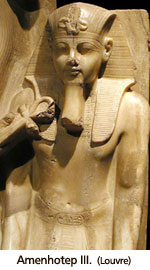
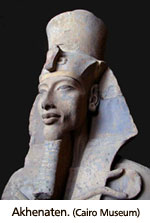 The Amarna Letters are, for the most part, diplomatic correspondences between minor kings and rulers from Syria, Lebanon, and Canaan and their Egyptian overlords. The letters show that, during the reign of Amenhotep III, Egypt had tight political control over Syria and Palestine, but that during the reign of Akhenaten, Egyptian influence was collapsing. Numerous Egyptian outposts were being overrun by invaders and the vassal kings and commanders were powerless to stop them. Chaos was mounting as kings were turning against neighboring kings; fortresses of former allies became enemy fortresses. There were numerous appeals to Akhenaten for help, but the cries went unanswered.
The Amarna Letters are, for the most part, diplomatic correspondences between minor kings and rulers from Syria, Lebanon, and Canaan and their Egyptian overlords. The letters show that, during the reign of Amenhotep III, Egypt had tight political control over Syria and Palestine, but that during the reign of Akhenaten, Egyptian influence was collapsing. Numerous Egyptian outposts were being overrun by invaders and the vassal kings and commanders were powerless to stop them. Chaos was mounting as kings were turning against neighboring kings; fortresses of former allies became enemy fortresses. There were numerous appeals to Akhenaten for help, but the cries went unanswered.
The pleas usually start with a groveling salutation. Typical of the Amarna Letters is this one, sent by Abi Milku of Tyre:
To the king, my lord, my god, my Sun: Message of Abi-Milku, your servant. I fall at the feet of the king, my lord, seven times and seven times. I am the dirt under the sandals of the king, my lord. My lord is the Sun who comes forth over all lands day by day, according to the way (of being) the sun, his gracious father, who gives life by his sweet breath and returns with his north wind; who establishes the entire land in peace, by the power of his arm. 12
There are ten surviving correspondences13 between king Shuwardata and Akhenaten. Shuwardata was the king of the Hebron district, as he himself states in letter EA#281. After the required greetings to Akhenaten, Shuwardata writes:
My cities are rebelling against me... archers are needed... like in the city of Hebron... they trembled before the Pharaoh... I prostrate myself before the Pharaoh... know that the hostilities are great against me... send archers...
If there are correspondences between the king of Hebron and a Late Bronze Age pharaoh, Akhenaten, then Hebron must have been in existence at that time.
This translation and interpretation has been confirmed by the distinguished scholars W.F. Albright and James B. Pritchard.14 If there are correspondences between the king of Hebron and a Late Bronze Age pharaoh, Akhenaten, then Hebron must have been in existence at that time.
Blunder number three: There is additional evidence that Hebron existed in the Early Iron Age (1250-1000 BCE), the era of Joshua's conquest. In the vicinity of Luxor, Egypt, is the great temple of Medinet Habu, built by the last great pharaoh of ancient Egypt, Ramses III (c.1175 BCE). It looks more like a fortified city, with numerous buildings, palaces, and temples. The largest temple is called the Mansion of Millions of Years of User-Maat-Re-Meriamum (Ramses III). More than 75,000 square feet of engravings and hieroglyphics cover its walls!
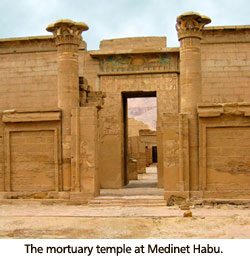 Some of the hieroglyphics record various trade routes that were used by the Egyptian military. A few of those routes were in the land of Canaan, and one in particular ran south to north, paralleling the western coast of the Dead Sea. It lists the cities, in their proper order, that were along the route. One of those cities is Hebron.15
Some of the hieroglyphics record various trade routes that were used by the Egyptian military. A few of those routes were in the land of Canaan, and one in particular ran south to north, paralleling the western coast of the Dead Sea. It lists the cities, in their proper order, that were along the route. One of those cities is Hebron.15
If Hebron was listed in the early Iron Age as a city off a main trade route, it must have surely existed at that time. Needless to say, there would be no reason to record a landmark if it was no longer there.
Hammond had indeed found evidence of Late Bronze occupation is six different areas of Tel Hebron!
Blunder number four: A major breakthrough in the story of Hebron occurred in recent years. Earlier, we noted that Hammond's excavation of Hebron started in 1963 was interrupted by the war of 1967 and not resumed. Much of Hammond's finds were not evaluated or published. However, Dr. Hammond encouraged his student, Jeffery R. Chadwick, to carefully examine the Hebron material and follow up with on site excavation. Not until September of 2005 were the results of his labors made public.16 Chadwick, who is presently a senior research fellow at Jerusalem's William F. Albright Institute for Archaeological Research, revealed that Hammond had indeed found evidence of Late Bronze occupation in six different areas of Tel Hebron!
Blunder number five: During a new expedition in 1998, Israeli archaeologist Yuval Peleg found more than 50 burials with grave goods dating to the Late Bronze Age. Concerning Early Iron Age evidence of occupation, a great amount of pottery has recently been found, much of it in the conventional Israelite collared-rim style, typical of the Early Iron Age. The architecture and plastering techniques of the strata containing the collared-rim pottery was conventional Early Iron Age construction.17
As mentioned earlier, Hebron was one of the cities visited by the twelve spies sent out by Moses. According to the Bible, when the spies returned to Moses, they claimed ...the people who live in the land, are strong, and the cities have great walls, and moreover we saw the children of giants there... we were in our own sight as grasshoppers, and so were we in their sight.18
What led the Israelites spies to think that the land was inhabited by giants? Archaeology can supply the answer.
The city wall and guard towers of Late Bronze Hebron were constructed entirely of huge stone blocks, some more than six feet in length weighing more than 10 tons each. These are called cyclopean stones, from the word Cyclops, the name of the mythological Greek giant. A tower that guarded the city gate, though most of its height was torn down, still stands 20 feet high. The original tower was probably about 60 feet in height. We can only imagine how high the city walls of Hebron were. We can also imagine what must have passed through the minds of the 12 spies of Moses when they first saw the mighty walls of Hebron. Surely, the walls were protecting the city from giants!
Blunder number six: As the Late Bronze Age was yielding way to the onset on the new Iron Age, the city wall and its gates collapsed. One of the cyclopean stones came crashing down on a house which had been destroyed by an intense fire. The fallen stones, the devastation, and the signs of conflagration during the early Iron Age testify to the Biblical account of Joshua's conquest.19
The evidence is incontrovertible. To say that no Late Bronze/Early Iron Age artifacts were to be found in Hebron is simply untrue. Yet, if there is so much evidence that Hebron was indeed inhabited during the era of the conquest, why do some archaeologists and historians still continue to claim there is no such evidence?
The present spokesman for the "non-inhabited Hebron" camp is Israeli archaeologist, Dr. Avi Ofer. He himself discovered pottery shards from the Late Bronze Age.20 Brushing it off as a quirky find, something that came from someplace else and did not originate where he found it, he vocally claims that the city was not inhabited during that era.
Why would an archaeologist negate his own findings? Dr. Ofer is not only an archaeologist; he is also a leader in the Peace Now movement in Israel. This left-wing political organization believes in peace at any cost, favoring to give as much land as necessary to the Palestinians in return for promises of good behavior. Hebron, of course, is much contested in the current Middle East debate. Ofer admits that its importance is great, yet favors ceding it to, what he believes is, the soon-to-be country of Palestine.
If the historical Jewish conquest of Hebron is discounted, then the Jewish claim to the area is not valid.
Ofer has said, "Tel Hebron [the site of the Cave of the Patriarchs, which is sacred to all three monotheistic religions] is the second most important archeological site in Israel, second only to Jerusalem and the Temple Mount. However, as unfortunate as it may be, the site belongs to the Palestinians." He therefore strongly opposes Jews living in Hebron,21 and gladly lends his academic voice to those who claim that Hebron was not among Joshua's conquests. Put quite simply, if the historical Jewish conquest of Hebron is discounted, then the Jewish claim to the area is not valid.
Lest you wonder how a scientist can recant the significance of his own discovery, it is important to understand that archaeology is not the exact science that laymen assume it to be. It is an interpretive art based on logic, deduction, and intuition. Tangible finds such as inscriptions, pottery, foundations of buildings, evidence of destruction must be given life and meaning in order to fit into an historical, social, religious, and economic context. This interpretation is where the true expertise of the archaeologist comes into play. But, like any interpretive art, it can be subject to political, social and religious pressures and prejudices from outside and from within academic circles. Adam Mikaya wrote in Biblical Archaeological Review,22 "As anyone who has made his living in academia knows, (archaeology) is a political jungle... Indeed, the higher stakes only intensify the political animosities."
And, Hebron is a perfect case in point. Before the finding of concrete evidence, Hebron was flaunted as contrary to the Biblical narrative of an Israelite conquest of Canaan. With the discovery of artifacts in recent years, Hebron now boasts of incontrovertible evidence of the Israelite conquest. But we mustn't hold our collective breath waiting for the anti-Biblicists to admit their mistake. In the words of Jonathan Swift, "There's none so blind as they that won't see."23
1. Josdephus Flavius, Wars of the Jews, book 4, chap. 9, para.7.
2. Genesis 23.
3. Numbers 13:21-24.
4. Joshua chapter 10.
5. II Samuel 2:11.
6. A very brief survey was conducted in the 1920s by Albright, but no excavations were carried out at that time.
7. See Charles R. Krahmalkov, "Exodus Itinerary Confirmed by Egyptian Evidence," Biblical Archaeological Review (henceforth referred to as BAR) 20, 1994.
8.William Stiebing Jr., Out of the Desert (Buffalo, NY: Prometheus Books, 1989), .92.
9. Ibid. Krahmalkov. Also, Mazar, 177.
10. http://www.gutenberg.org/dirs/etext06/8dlit10.txt
11. Based on pottery shards that have been casually found. http://www.arij.org/pub/Hebron-Profile.pdf
12. Moran, ed. ,The Amarna Letters, 233.
13. Amarna Letters EA# 271, 277-284, 290a. 14. James B. Pritchard, Ancient Near Eastern Texts (Princeton, NJ: Princeton University Press, 1950), 487 note 13 and Lamoine DeVries, Cities of the Biblical World: An Introduction to the Archaeology, Geography, and History of Biblical Sites, (Peabody, MA: Hendrickson Publishers, 1997) 114-115. See http://www.specialtyinterests.net/eae.html#281.
15. Jan Jozef Simons, Handbook for the study of Egyptian topographical lists relating to Western Asia. (Leiden, Germany: E. J. Brill, 1937), 164-169. 16. See Jeffrey R. Chadwick, "Discovering Hebron," BAR Sept/Oct 2005.
17. Ibid.
18. Numbers 13:28 and 33.
19. See Chadwick, BAR Sept/Oct 2005.
20. See http://www.hebron.edu/Magazine/Archive/M1_F2/5-26.pdf, p. 92.
21. http://www.israelnationalnews.com/article.php3?id=2052.
22. Adam Mikaya, "The Politics of Ebla," BAR, Sept/Oct 1978.
23. Jonathan Swift Polite Conversation. Dialogue iii.
